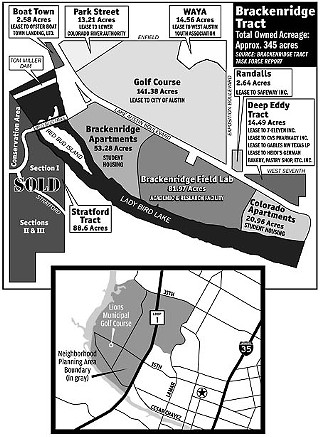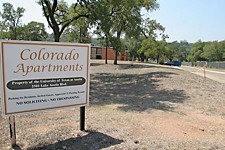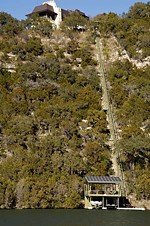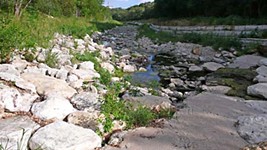UT's Brackenridge Tract: For Love or Money?
West Austin readies for another battle over redevelopment
By Jacob Cottingham, Fri., Sept. 26, 2008
Col. George Washington Brackenridge, Civil War profiteer and philanthropist, could have never suspected how much controversy his gift to the University of Texas would eventually cause. The 503 acres of the Brackenridge Tract, along the Colorado River in West Austin, are once again under consideration for massive new development. Neighborhood groups, university departments, graduate students, and local golfers are all wary of what redevelopment might mean. The financial and political challenge is considerable – pitting the current benefits of popular recreation, urban open space, ball fields, biological research, and affordable housing against the potential financial and community benefits of economic growth, commercial and recreational development, and a more efficient (i.e., profitable) use of university resources.
The Brackenridge land, bequeathed in trust in 1910 for the benefit of the University of Texas, most prominently includes the city of Austin's Lions Municipal Golf Course, a UT biological field laboratory, and married student housing. The golf course dates back to 1928, when the Lions Club raised the funds for its construction. The university itself built a nationally ranked field laboratory on the land in 1967. Other public and private interests lease land from the university – including Oyster Landing, the Lower Colorado River Authority (site of many public meetings), Randalls supermarket, and the West Austin Youth Association, a nonprofit that annually provides recreational opportunities like youth sports leagues for 4,000 kids.
In March, the UT Board of Regents hired New York-based architecture and design firm Cooper, Robertson & Partners, at a cost of $5.1 million, to create a "conceptual master plan" for redeveloping the remaining 346 acres from the original deed (the rest having been sold off earlier in the century). The firm is scheduled to develop the plan over the next several months and report back to UT and the community in June 2009. It will be up to that firm to give shape to a cohesive, long-term vision for the land.
Some insight into this process can be gleaned by reading through the Brackenridge Task Force report, which quotes UT President William Powers saying because UT "has no plans for program and facility expansion on the Brackenridge Tract ... the revenue potential of the property affords the most valuable benefit as U.T. Austin struggles to maintain and improve its competitive position among the nation's most highly regarded research universities." In short, it's all about the dollars.
While the consultants gather preliminary data and measure community opinion, old alliances are once again springing into action to defend West Austin's green space.
This is the third time in 35 years that the land has been evaluated for development potential. In 1973, golfers and neighborhood activists were able to preserve the course after the university terminated the lease in 1972. In 1987, the Save Muny organization was born, dedicated to keeping the golf course owned by the city and open to the public. By 1989, Save Muny had spearheaded a deal to extend the city's lease until 2019, although there is some question as to how easily that contract could be broken. Currently the city pays UT $345,600 a year for the course.
August "Happy" Harris, president-elect of the West Austin Neighborhood Group, says the group is "operating cautiously" because they have yet to hear anything certain about what UT's redevelopment plans may include. In the meantime, they've surveyed residents about the land. "It's more about what is actually on the site now and how it's being used that we are gathering comments on," he said.
WANG surveyed several hundred residents of the Central West Austin Combined Neighborhood Planning Area (west of MoPac, south of 35th and 38th streets, with the lake on the west and south). Respondents were asked "to determine what portions of the tract they would like to see remain as it is today." According to the WANG website, 49% want to see Lions Golf Course preserved as it is, while 24% want to see the course preserved with additional nongolf activities incorporated. Harris said the results show that the "vast majority wanted it preserved as a golf course and green space." The same West Austin respondents also expressed overriding concerns for potential traffic and congestion, the loss of green space, and overbuilding.
Harris believes the attractiveness of the tract makes it an easy target for redevelopment schemes. "For those folks [at UT] that want the money now, they'll say the Legislature is pushing them to better use their assets – and this is one of their more attractive assets." But he believes there are better options. He says the university has more than a billion dollars in property on and off campus, as well as another potential billion in oil and gas revenues. Yet, the task force summarizes, "the tremendous increase in the value of the [Brackenridge Tract] compels a new vision for the tract that will provide greater financial benefits to the University in support of its educational mission."
Harris couldn't disagree more. "Nothing needs to change, nothing has to change," he says, "and there's a very strong contingent of folks who value their neighborhoods and don't want to see change that would disrupt that." Paul Milana, a partner at Cooper Robertson working on the Brackenridge project, says he understands that position. "You're going to get a lot of people who are resistant to change because they value what they have, and I think that's a very normal thing, and it needs to be taken seriously."
Golf, Little League, and Grad Students
It's also true that not everyone wants things to remain the same. The task force recommendation certainly doesn't favor Lions. It notes, "While the [lease] permits three five-year renewal terms, the Task Force does not recommend that it be renewed beyond the initial 30-year term because of the very significant changes in conditions since the Agreement was first adopted."
Roy Bechtol of Bechtol Golf Design, a course architect firm, has joined with UT alum and professional golfer Tom Kite and local attorney Pike Powers to form what Powers calls a "group that seeks to bring comprehensive development plans to the attention of the University of Texas system." Because UT's project request with Cooper Robertson says "anything you tell them can be taken and used without any compensation," Powers has been reluctant to share details of their proposal. Bechtol did tell the Statesman the group would propose a "fitness-themed" development that upgrades the current golf course with a multimillion-dollar investment, to include a hotel, spa, clubhouse, conference center, and practice space. Powers described it as "not a classical development proposal" and claimed it would be "more Austin-centric than anything else the University of Texas will see."
Local golfers say that such a change would destroy the casual dress code and inexpensive pricing of the municipal course. In August, West Austin News published a fervent defense of the current Lions course by another UT graduate and professional golfer, Ben Crenshaw. He wrote, "If development plans proceed within the golf course ... [i]t will cease to be a municipal golf course with its arms wide open to everyone in this community." Powers responds that his group proposes "an affordable golf course based on a number of ideas to make the course playable for people in the neighborhood." Currently at Lions, the most expensive rounds of golf cost $20, a rare bargain in the usually more posh world of golf.
Local environmental activist Mary Arnold, a co-chair of Save Muny, also serves on the board of WANG and on the city's golf advisory board. She was a member of the group that in 1989 negotiated the current Muny deal between the city and university. Arnold says the Bechtol plan "certainly destroys the field lab and doesn't leave much of the golf course. It's not a plan I could support in any way, shape, or form." Powers declined to comment on the fate of the field lab under his group's proposal.
Among the many factors influencing future options, the Brackenridge Field Laboratory, operated by UT's School of Biological Sciences on an 88-acre tract, additionally complicates any future redevelopment. Professor Robert Jansen, chair of the integrative biology section, says the field lab has both teaching and research missions. "About 500 students take classes out there on a recurring basis, so it has a very important mission for the university in terms of teaching field-oriented courses," he explains. "These outdoor studies in ecology or behavioral disciplines are the kind of courses that simply can't be taught indoors. ... It is very unusual to have such a field station in such close proximity to an urban university, but that's one of the major advantages – students can actually get out there," he says, via shuttle bus or other affordable access. The research benefits – primarily in ecology, evolution, and animal and plant behavior – are shared among the faculty and graduate students. U.S. News & World Report ranked the graduate program the eighth best in the nation, and it has been deemed the top program in UT's College of Natural Sciences.
Jansen says the past 40 years of biological record-keeping on the site are also invaluable, saying, "Historical record is extremely important for asking questions in ecology, evolution, and behavior." He cited his colleague Larry Gilbert's work in organic controls of fire ants as being among the more intriguing projects at the lab. The faculty members whose research depends on the field lab are certainly vocal opponents of redevelopment. In summation, Jansen describes the lab as "a very, very important facility in terms of maintaining our national ranking and attracting graduate students" and says its loss would have "an extremely negative impact" on the integrative biology section.
The task force has so far opted to recommend a change of venue for the lab: "A biological reserve is important to the University's academic purposes," it states, "but it is not clear that the field laboratory should remain at its current location." Jansen acknowledges that although faculty members have argued their case as best as they can, the university has yet to signal that the lab is off limits from any redevelopment.

Click for a larger PDF
From a broader city perspective, Arnold says, "The golf course and field lab represent urban green spaces, and with everything being built Downtown, we still need to maintain our green space." She adds that the tract's location in the city's Drinking Water Protection Zone should require some defense against intense development. "The portions that do abut Lady Bird Lake should have deep setbacks and be more natural – particularly we wouldn't want development to impinge on those setbacks." Milana acknowledges the importance of the neighborhood's character and says the firm will be "making sure that whatever happens on the Brackenridge Tract respects and is sensitive to the adjacent uses and adjacent neighborhoods."
Another critical element to green space and neighborhood life is the West Austin Youth Association. The privately funded group has been around since 1981. Aside from the three full-size gyms and two Little League fields that are on the tract, WAYA has a Champs League on Sunday for kids with disabilities. Executive Director Courtney Houston is deferential to UT. "We think the university has every right to look at the highest and best use, and we have been nothing but helping them out to that extent," she says. "We'd like to stay if possible, but if not, we'll probably go to the city at that point."
A move would not be automatic. WAYA facilities serve children from more than 60 Austin-area ZIP codes, on teams for which everyone gets to play, and everyone who signs up gets on a team. "What we are is a meeting place and a gathering place. ... You may meet someone that lives down the street from you that may go to a different church or go to a private school," Houston says. Houston is perhaps reassured by the sheer number of neighbors involved in the leagues; WAYA has 400 motivated parents volunteering as coaches. (It has not gone unnoticed by planners that among those volunteers are some of the most politically and financially influential people in town.)
The task force recommendations on this score offer Houston and WAYA some reassurance, if no guarantee. "A master planning document of the quality envisioned by the Task Force will likely include open space and community space, which might include community services, perhaps similar to those currently provided on this portion of the tract."
Where's the City?
Although golf, research, and neighborhood recreation have garnered most of the argument, the Brackenridge Tract also contains two complexes of affordable housing for married UT graduate students, many of them foreign. Harris says this housing is vital. "It provides a sense of community for these students and their families – and that represents a chunk of the affordable housing that also provides a great deal of diversity." Over the years, many international students have lived there, and Harris says their involvement in the local school system, especially at nearby Mathews Elementary, is also an advantage for the community.
Although Harris says he has appreciated the openness of the discussion thus far, both with Bechtol and Cooper Robertson, he cautions, "That's not to say that others aren't out there developing their own plans to submit to the university at some point in time." Powers agrees: "Based on my conversations ... there are a number of groups interested in proposing and being considered and being selected. It's a wide-open ball game."
The neighbors have recently taken issue with the next public step in the process, forums on Nov. 3 and 4 – Election Day. "A lot of people are not going to want to put their emphasis and time on the Brackenridge Tract," Arnold says, "while they need to be working on a presidential election." She's also concerned about the lack of planned contact or interaction between the master-planning group and the public from November to June.
Harris and Arnold see opportunity for a partnership between the city and university. Arnold says Save Muny is "trying to explore other ways the city can offer benefit to the University of Texas other than developing the Brackenridge Tract." Harris lists several negotiating strategies, citing an important water line or other parcels of land that the city could effectively swap with the university. Noting the appeal of Kenneth Shine, UT executive vice chancellor for health affairs, for community support in building a medical center in Austin, Harris suggests, "How about giving us the golf course and WAYA, and we'll do all we can to help get the med school in place?"
Assistant City Manager Sue Edwards says that, partly due to the recent ascent of a new City Council and a new city manager, "We have no formal position on Brackenridge." She says City Manager Marc Ott is meeting with council to get feedback on the city's response. Edwards was unaware whether the city had ever purchased land from the university and declined to express the city's current perspective on the tract, saying, "We don't know where UT is coming from yet."
In the meantime, each party will be figuring out how to best preserve its interests while planning for an uncertain future. Independent developers will hatch their schemes, and Cooper Robertson will continue to gather data and draw up plans, as Save Muny and WANG look for city-based solutions. Milana sums up the challenge facing the planners: "We have to complete our charge, and in the process of that, we have to respect, collectively, people's wishes." The proposal to come next spring is likely to be an attempt to please all the various constituencies. Whether any such broad solution is possible remains in the balance.
Got something to say on the subject? Send a letter to the editor.












